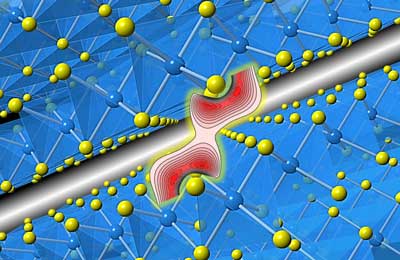| Posted: Feb 16, 2018 |
Precision experiments reveal gaps in van der Waals theory
(Nanowerk News) The discovery of graphene, with its high strength-to-weight ratio, flexibility, electrical conductivity, and ability to form an impenetrable barrier, led to an explosion of interest in 2D solids. Weak, long-range interactions give 2D solids some of their most interesting behaviors; therefore, understanding these interactions is crucial for further developing these materials. However, experimental support for theoretical modelling of the van der Waals interactions that hold these materials’ layers together has been wanting.
|
|
Now, an international research group led by the University of Tsukuba and Aarhus University has performed synchrotron X-ray diffraction experiments on titanium disulfide (TiS2)—a transition metal dichalogenide (TMD) material with a layered 2D structure—and compared the results with theoretical calculations. Their benchmark work was recently published in Nature Materials ("X-ray electron density investigation of chemical bonding in van der Waals materials").
|
 |
|
“The interaction between layers in van der Waals materials such as TiS2 has a significant bearing on their modification, processing, and assembly,” study co-author Eiji Nishibori says. “By modelling experimental synchrotron data and comparing it with density functional theory calculations, we revealed surprising information about the nature of the electron sharing between layers in these materials.”
|
|
TiS2 is an archetypal van der Waals material, with layers comprising sheets of titanium and sulfur interacting through strong chemical bonds, where electrons are shared between atoms, resulting in a relatively fixed structure. Between these sheets, long-range S…S van der Waals interactions attract the layers to one another allowing them to build up, forming solid materials. These interactions are known to be much weaker than those within the 2D sheets, however, using high-energy synchrotron X-ray radiation to precisely measure a single TiS2 crystal, the researchers were able to show that the interlayer interactions are in fact stronger than theory indicates, and involve significant electron sharing.
|
|
“This work provides a fundamental understanding of an exciting class of materials with numerous potential applications in technologies such as ion batteries, catalysis, and superconductors,” lead author Hidetaka Kasai says. “Our experiments are the first to reveal the true nature of the interactions that make 2D materials so interesting, and we hope they will underpin many future developments in this area.”
|
|
The outstanding agreement of the synchrotron diffraction data with theoretical calculations in describing the intralayer Ti-S interactions, supports the validity of these new-found differences for the long-range interactions across the interlayer gaps. The findings are expected to substantially contribute to the fundamental understanding of weak chemical bonding in 2D layered materials in general, and to the development of TMD materials.
|

